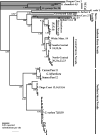Evolutionary diversification of cryophilic Grylloblatta species (Grylloblattodea: Grylloblattidae) in alpine habitats of California
- PMID: 20525203
- PMCID: PMC2898686
- DOI: 10.1186/1471-2148-10-163
Evolutionary diversification of cryophilic Grylloblatta species (Grylloblattodea: Grylloblattidae) in alpine habitats of California
Abstract
Background: Climate in alpine habitats has undergone extreme variation during Pliocene and Pleistocene epochs, resulting in repeated expansion and contraction of alpine glaciers. Many cold-adapted alpine species have responded to these climatic changes with long-distance range shifts. These species typically exhibit shallow genetic differentiation over a large geographical area. In contrast, poorly dispersing organisms often form species complexes within mountain ranges, such as the California endemic ice-crawlers (Grylloblattodea: Grylloblattidae: Grylloblatta). The diversification pattern of poorly dispersing species might provide more information on the localized effects of historical climate change, the importance of particular climatic events, as well as the history of dispersal. Here we use multi-locus genetic data to examine the phylogenetic relationships and geographic pattern of diversification in California Grylloblatta.
Results: Our analysis reveals a pattern of deep genetic subdivision among geographically isolated populations of Grylloblatta in California. Alpine populations diverged from low elevation populations and subsequently diversified. Using a Bayesian relaxed clock model and both uncalibrated and calibrated measurements of time to most recent common ancestor, we reconstruct the temporal diversification of alpine Grylloblatta populations. Based on calibrated relaxed clock estimates, evolutionary diversification of Grylloblatta occurred during the Pliocene-Pleistocene epochs, with an initial dispersal into California during the Pliocene and species diversification in alpine clades during the middle Pleistocene epoch.
Conclusions: Grylloblatta species exhibit a high degree of genetic subdivision in California with well defined geographic structure. Distinct glacial refugia can be inferred within the Sierra Nevada, corresponding to major, glaciated drainage basins. Low elevation populations are sister to alpine populations, suggesting alpine populations may track expanding glacial ice sheets and diversify as a result of multiple glacial advances. Based on relaxed-clock molecular dating, the temporal diversification of Grylloblatta provides evidence for the role of a climate-driven species pump in alpine species during the Pleistocene epoch.
Figures




References
-
- Kaufman DS, Porter SC, Gillespie AR. In: The Quaternary Period in the United States, 1. Gillespie AR, Porter SC, Atwater BF, editor. Vol. 1. Amsterdam, The Netherlands: Elsevier; 2004. Quaternary alpine glaciation in Alaska, the Pacific Northwest, Sierra Nevada, and Hawaii; pp. 77–103. [Rose J (Series Editor): Developments in Quaternary Science]
-
- Ehlers J, Gibbard PL. Quaternary Glaciations. Extent and Chronology: Part I Europe. Den Haag: Elsevier; 2004.
-
- Thompson RS, Anderson KH. Biomes of western North America at 18,000, 6000 and 0 C-14 yr BP reconstructed from pollen and packrat midden data. Journal of Biogeography. 2000;27:555–584. doi: 10.1046/j.1365-2699.2000.00427.x. - DOI
-
- Frenzel B. History of flora and vegetation during the Quaternary North America. Progress in Botany. 2005;66:409–440. full_text.
-
- Chabot BF, Billings WD. Origins and ecology of the Sierran alpine flora and vegetation. Ecological Monographs. 1972;42:163–199. doi: 10.2307/1942262. - DOI
Publication types
MeSH terms
Substances
LinkOut - more resources
Full Text Sources
Molecular Biology Databases

